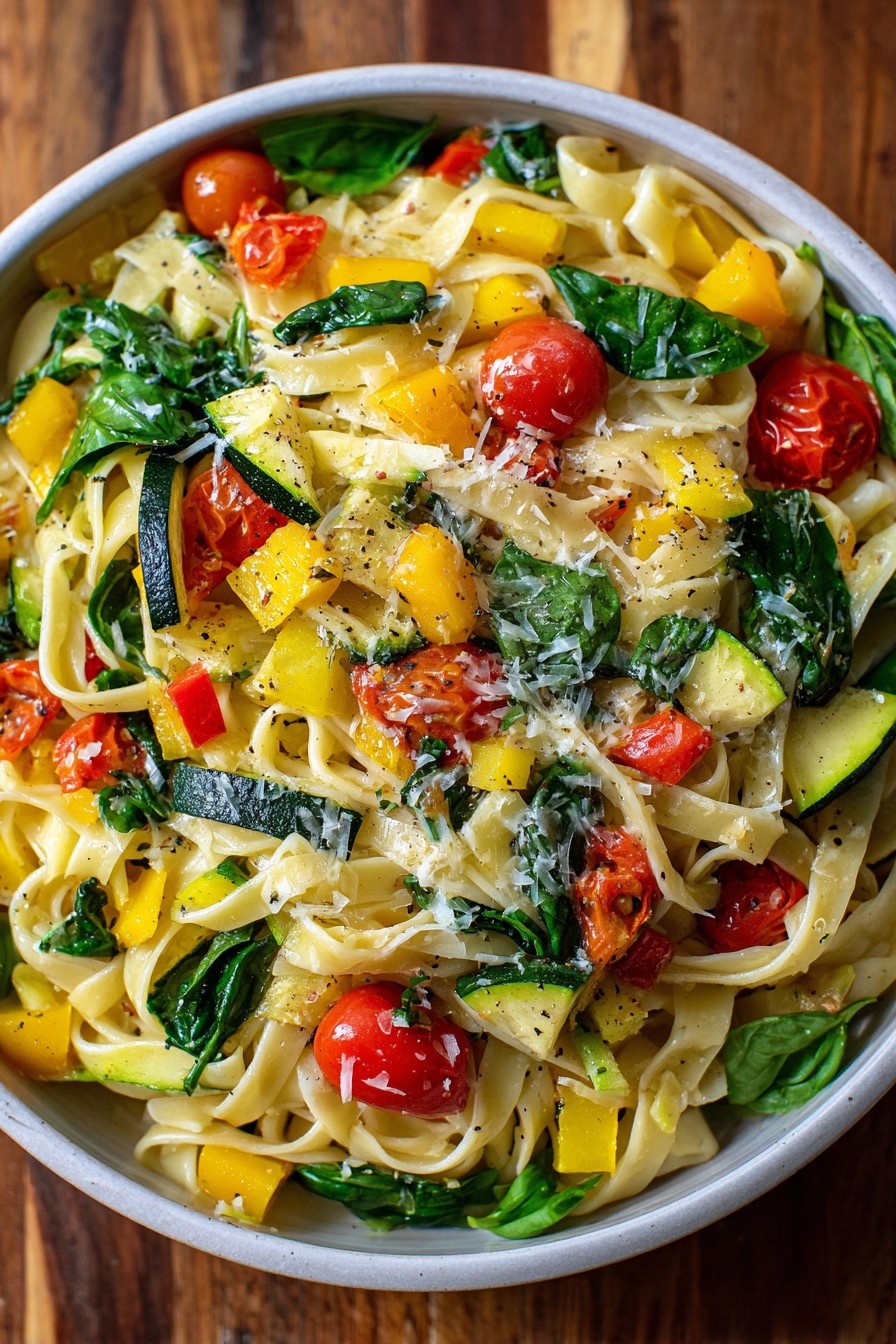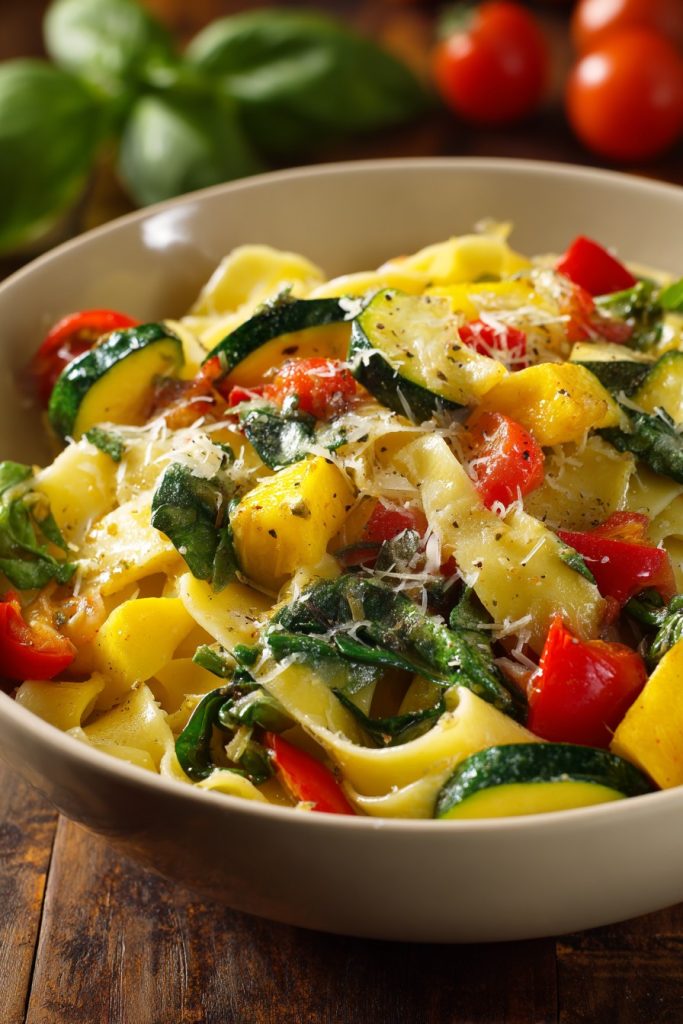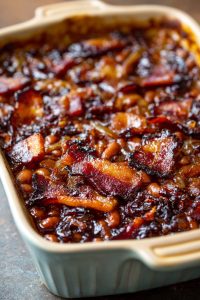Just thinking about this dish takes me back to those golden afternoons at Grandma’s house, where the scent of fresh tomatoes and basil would drift through the screen door and mingle with the sound of laughter from the garden. Joy filled every corner of that old kitchen, where flour-dusted hands and vegetable-stained aprons told stories of love passed down through generations. This recipe captures that same magic – the comforting embrace of homemade pasta surrounded by vegetables that taste like sunshine itself.
Why This Recipe Works
- The combination of fresh summer vegetables creates layers of flavor that canned alternatives simply can’t match, bringing back memories of helping Grandma pick tomatoes still warm from the sun
- Hand-rolled pasta dough connects us to generations past, turning simple ingredients into something that feels like a warm hug from childhood
- Slow-simmered sauce allows all the vegetable flavors to meld together beautifully, just like those long summer evenings when dinner conversations stretched for hours
- The perfect balance of textures – from al dente pasta to tender-crisp vegetables – reminds me of learning to cook alongside my mother, who always said texture matters as much as taste
- Using seasonal produce means every bite tastes like the best of summer, transporting you right back to those carefree days of childhood
Ingredients
- 2 cups all-purpose flour, plus extra for dusting
- 3 large eggs, at room temperature
- 1 tablespoon olive oil
- 1/2 teaspoon salt
- 2 tablespoons unsalted butter
- 1 medium yellow onion, finely chopped
- 3 cloves garlic, minced
- 2 medium zucchini, cut into 1/2-inch cubes
- 1 red bell pepper, diced into 1/2-inch pieces
- 2 cups cherry tomatoes, halved
- 1 cup fresh spinach leaves, roughly chopped
- 1/4 cup fresh basil leaves, torn
- 1/2 cup grated Parmesan cheese
- Salt and freshly ground black pepper to taste
Equipment Needed
- Large mixing bowl
- Pasta roller or rolling pin
- Large pot for boiling water
- Large skillet or sauté pan
- Cutting board and sharp knife
- Wooden spoon
- Colander
- Measuring cups and spoons
Instructions

Creating the Perfect Pasta Dough
Making pasta from scratch always takes me back to my grandmother’s kitchen, where flour would dust everything like winter’s first snow. Begin by creating a well with your 2 cups of flour right on the countertop, just like she taught me when I was barely tall enough to see over the table edge. Crack those 3 room-temperature eggs into the center, add the tablespoon of olive oil and half teaspoon of salt, then use a fork to gradually incorporate the flour from the sides inward. As the dough comes together, knead it with the heels of your hands for about 8-10 minutes until it becomes smooth and elastic, remembering how Grandma’s hands moved with such practiced ease. The dough should feel firm but pliable, not sticking to your fingers – if it feels too wet, add a tablespoon more flour; if too dry, sprinkle with water. Wrap it in plastic and let it rest for 30 minutes at room temperature, allowing the gluten to relax just like those peaceful afternoons waiting for dinner.
Rolling and Cutting the Pasta
There’s something meditative about rolling out pasta dough that connects me to all the women in my family who came before me. Divide your rested dough into four equal portions, keeping the others covered while you work with one piece at a time. Lightly flour your surface and rolling pin, then roll the first portion into a thin sheet about 1/8-inch thick, turning and flipping it occasionally to ensure even thickness. If using a pasta machine, start at the widest setting and gradually work down to number 6 or 7, remembering how my mother would let me turn the crank while she guided the dough through. Once you have your thin sheet, dust it lightly with flour and either cut it into fettuccine-width strips with a knife or use your pasta cutter attachment. Hang the cut pasta over a chair back or drying rack while you repeat with remaining dough, just like we used to do when the whole kitchen would become a pasta-making factory.
Preparing the Vegetable Medley
Chopping vegetables always reminds me of summer afternoons spent at the kitchen table with my mother, learning how to handle a knife properly while she told stories about her own childhood. Heat your large skillet over medium heat and melt the 2 tablespoons of butter until it foams slightly, then add your finely chopped onion and cook for about 5-7 minutes until translucent and fragrant. Add the minced garlic and cook for another minute until golden, being careful not to burn it – my grandmother always said burned garlic ruins the whole dish. Stir in your cubed zucchini and diced red bell pepper, cooking for 8-10 minutes until they begin to soften but still have some bite, then add the halved cherry tomatoes and cook for another 5 minutes until they start to release their juices. Season with salt and pepper to taste, remembering how my father would always sneak a taste from the spoon and declare it needed “just a pinch more” of something.
Cooking the Pasta to Perfection
Bring a large pot of generously salted water to a rolling boil – it should taste like the sea, my nonna used to say – and add your fresh pasta. Fresh pasta cooks much faster than dried, so watch carefully as it will be ready in just 2-3 minutes once it floats to the surface. Use a spider strainer or tongs to transfer the cooked pasta directly from the boiling water into your skillet with the vegetables, reserving about a cup of the starchy pasta water. The starchy water helps create a silky sauce that coats every strand, something my aunt taught me after years of her pasta dishes being the talk of every family gathering. Toss everything together over low heat, adding splashes of pasta water as needed until the sauce clings beautifully to the pasta.
Finishing Touches and Serving
This final step always fills me with the same anticipation I felt as a child when my mother would call “dinner’s ready!” and we’d all come running. Remove your skillet from the heat and stir in the fresh spinach leaves – they’ll wilt perfectly from the residual heat without becoming mushy. Sprinkle in most of your torn basil leaves and grated Parmesan cheese, saving some for garnish, and give everything one final gentle toss. The warmth of the pasta will release the basil’s essential oils, filling your kitchen with that same heavenly aroma I remember from childhood summers. Serve immediately in warmed bowls, topped with the remaining Parmesan and basil, and maybe even a drizzle of good olive oil if you’re feeling fancy, just like we did for Sunday dinners when all the cousins would gather around the big table.
Tips and Tricks
Making this veggie pasta truly special involves little touches that transform it from a simple meal into a memory-making experience. When working with your pasta dough, remember that the resting period is non-negotiable – it allows the gluten strands to relax, making the dough much easier to roll out without springing back. My grandmother would always cover her dough with a clean kitchen towel rather than plastic wrap, claiming it needed to “breathe,” and to this day I find it makes for more tender pasta. For the vegetables, don’t overcrowd your skillet – cook them in batches if necessary to ensure they caramelize properly rather than steaming, which creates those beautiful browned edges that add so much depth of flavor. If you’re making the pasta ahead of time, you can hang it to dry completely on pasta racks or broom handles covered with clean tea towels, then store it in airtight containers for up to a month, though fresh is always best. When cooking your fresh pasta, remember that it floats to the surface when done, but I always taste a piece about 30 seconds after it surfaces to ensure perfect al dente texture – my mother called this the “golden moment” when pasta is neither too firm nor too soft. For the sauce, if your vegetables aren’t releasing enough liquid, you can add a quarter cup of vegetable broth or white wine to deglaze the pan and create more sauce, scraping up all those delicious browned bits from the bottom. And finally, always warm your serving bowls – it keeps the pasta hot longer and makes the whole experience feel more special, just like my grandmother insisted on doing even for casual weeknight meals. These small details might seem insignificant, but they’re what turn cooking from a chore into a cherished ritual, connecting us to those who cooked before us and those who will cook after.
Recipe Variations
- For a creamy twist that reminds me of my aunt’s famous pasta dishes, stir in 1/2 cup of heavy cream or mascarpone cheese during the final minutes of cooking, creating a luxurious sauce that clings to every vegetable and pasta strand. This version always takes me back to holiday gatherings where rich, comforting foods filled the table and conversations lasted long into the evening.
- Add protein by including 1 cup of cooked chickpeas or white beans during the last 5 minutes of vegetable cooking, or for meat-eaters, 1 pound of Italian sausage removed from casings and browned before adding the onions. My father always preferred his with sausage, claiming it made the dish “substantial enough for a growing family,” though my vegetarian mother would playfully argue her version was superior.
- Create different pasta shapes by using the same dough to make tagliatelle, pappardelle, or even farfalle by cutting squares and pinching the centers – each shape holds the sauce differently and changes the eating experience. My cousins and I would compete to see who could make the most perfect farfalle, with Grandma judging our efforts with a kind but critical eye.
- Experiment with seasonal vegetables based on what’s available – in spring, use asparagus and peas; in fall, try butternut squash and kale; in winter, root vegetables like carrots and parsnips work beautifully. This adaptability reminds me of how my grandmother never followed recipes strictly but cooked with what her garden or the market provided, teaching us to be resourceful and creative.
- For a dairy-free version, omit the Parmesan and butter, using extra olive oil and a sprinkle of nutritional yeast for that cheesy flavor, or add toasted breadcrumbs for crunch. This variation takes me back to when my cousin developed lactose intolerance and my aunt ingeniously adapted all our family recipes so she never felt left out at family dinners.
Frequently Asked Questions
Can I make the pasta dough ahead of time?
Absolutely, and this is something my mother always did when expecting company. You can prepare the pasta dough up to 24 hours in advance – after kneading, wrap it tightly in plastic wrap and refrigerate. When ready to use, let it come to room temperature for about 30 minutes before rolling, which makes it much more pliable and easier to work with. The resting time actually improves the texture, allowing the flour to fully hydrate and the gluten to develop properly, resulting in more tender pasta. I remember my grandmother would often make her dough after breakfast for that evening’s dinner, saying the waiting made the pasta “more patient,” much like she believed waiting made people more appreciative.
What if I don’t have a pasta machine?
Not having a pasta machine is no obstacle at all – my grandmother never used one and her pasta was legendary throughout our neighborhood. Simply use a rolling pin and plenty of elbow grease, rolling the dough from the center outward and turning it frequently to maintain an even thickness. It might take a bit longer and require more effort, but there’s something deeply satisfying about creating pasta entirely by hand, connecting you to generations of home cooks who made do with what they had. The key is to roll the dough as thin as you can without tearing it – you should be able to see the shadow of your hand through it when held up to light, just like my mother taught me to check.
Can I use store-bought pasta instead?
While homemade pasta adds a special touch, high-quality store-bought pasta works beautifully when time is short. Look for bronze-die cut pasta, which has a rougher texture that better holds the sauce, and cook it according to package directions until al dente. The vegetable sauce is forgiving and versatile enough to complement any pasta shape, though I find wider noodles like fettuccine or pappardelle work best for capturing all those delicious vegetable pieces. My busy aunt would often keep good quality dried pasta on hand for weeknights but still made fresh pasta for Sunday dinners, teaching us that sometimes practicality and tradition can happily coexist.
How do I prevent the pasta from sticking together?
Preventing sticky pasta involves several simple techniques my mother drilled into me from childhood. First, make sure your boiling water is generously salted – this seasons the pasta from within and reduces stickiness. Second, don’t add oil to the cooking water despite what some recipes suggest, as it prevents the sauce from adhering properly later. Most importantly, once drained, toss the cooked pasta immediately with your sauce rather than letting it sit, and if you must hold it briefly, toss it with a small amount of olive oil. I remember my grandmother would always have her sauce ready before the pasta went into the water, declaring that “waiting pasta is unhappy pasta” that sticks together out of spite.
Can I freeze the finished dish?
You can freeze components but I don’t recommend freezing the fully assembled dish, as the texture of both pasta and vegetables suffers upon thawing. Instead, freeze the uncooked pasta dough wrapped tightly in plastic for up to 3 months, or freeze the vegetable sauce separately for up to 2 months. The pasta dough thaws beautifully in the refrigerator overnight, while the sauce can be reheated gently on the stove. My mother would always make extra sauce to freeze for busy nights, and coming home to that familiar aroma after a long day felt like getting a warm hug from her even when she wasn’t there.
Summary
This veggie pasta recipe connects generations through the simple joy of homemade cooking, blending fresh garden vegetables with hand-rolled pasta to create a dish that tastes like family memories and summer afternoons spent together in the kitchen.



